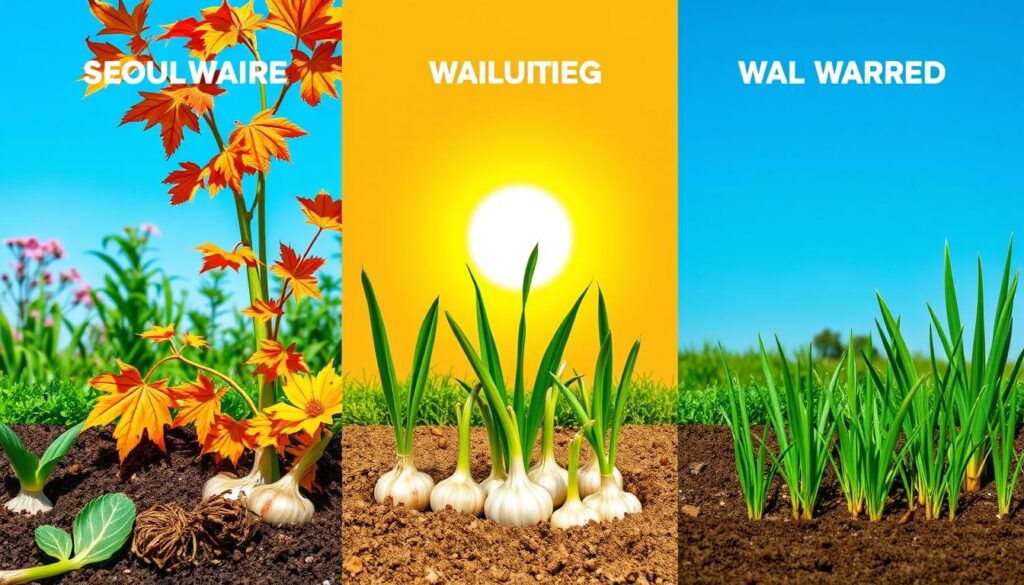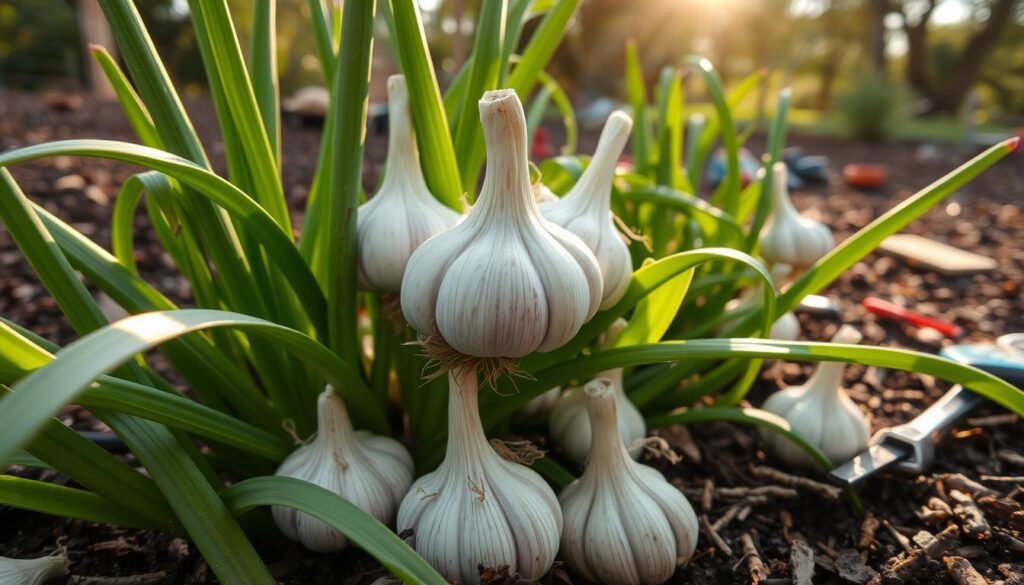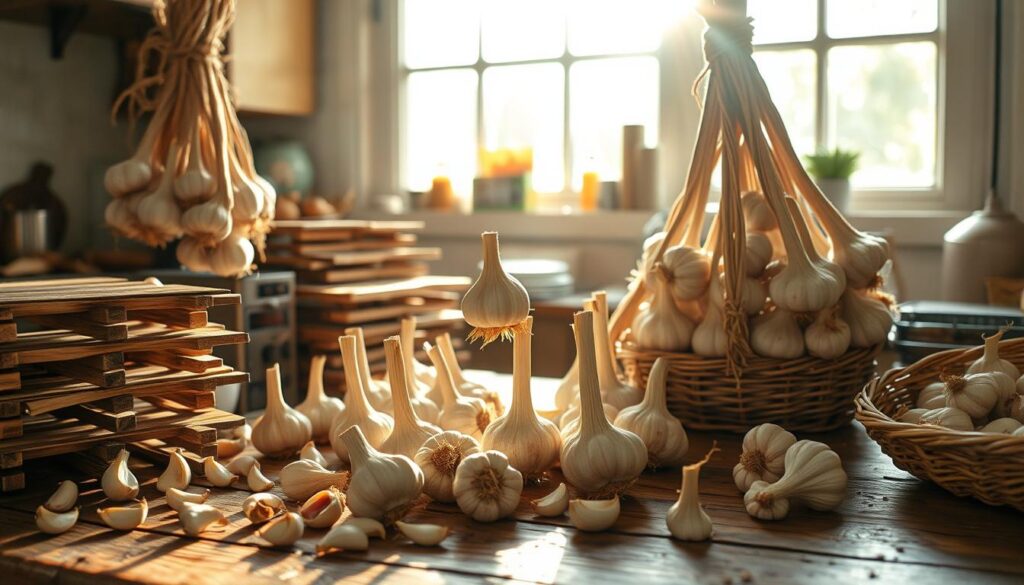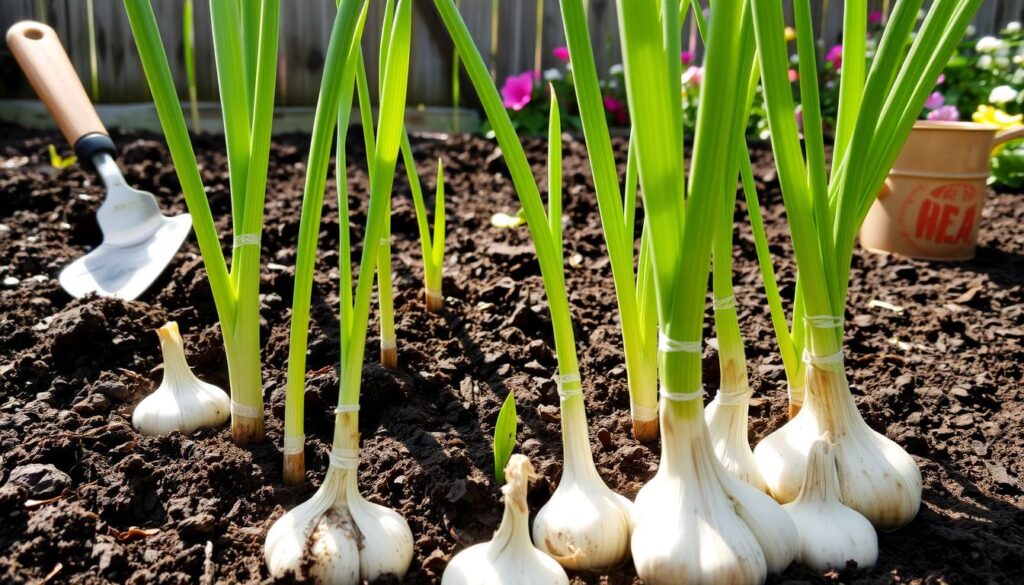Welcome to our guide on growing garlic. We’ll cover everything you need to know to grow delicious, homegrown garlic. Planting garlic can be rewarding, and with the right tips, you can have a great harvest. This guide is for both seasoned gardeners and beginners, covering the best soil, climate, and care for growing garlic.
We aim to give you expert advice on growing garlic. You’ll learn about planting, harvesting, curing, and storing. With our guide, you’ll become a pro at growing garlic and enjoy its many benefits.
Key Takeaways
- Learn the basics of how to grow garlic and planting garlic
- Discover the best garlic growing tips for a successful crop
- Understand the importance of soil, climate, and care instructions
- Get expert advice on planting, harvesting, and storing garlic
- Learn how to grow flavorful, homegrown garlic with our guide
- Improve your gardening skills with our tips and techniques on how to grow garlic
Why Growing Your Own Garlic Is Worth It
Growing your own garlic is a rewarding experience. It offers many benefits beyond cooking. With over 600 garlic varieties, you can pick the ones you like best. This makes it easy to add organic garlic cultivation to your garden.
One big plus of growing your own garlic is saving money. You won’t have to buy expensive garlic from stores. Plus, you can choose the best soil for garlic to make sure it grows well.
Health Benefits of Home-Grown Garlic
Garlic is full of antioxidants, vitamins, and minerals. It’s great for a healthy diet. Home-grown garlic is even better because it’s more nutritious and safer to eat.
Cost-Saving Advantages
By growing your own garlic, you can cut down on grocery costs. You’ll always have fresh, tasty garlic on hand.
Variety Selection Options
There are so many garlic varieties to try. You can find the perfect flavor for you, whether you like it mild or strong.
Growing your own garlic is fun and rewarding. It’s good for your health, wallet, and taste buds. By picking the right garlic varieties and using good organic garlic cultivation methods, you’ll get a big harvest of delicious garlic.
Understanding Different Garlic Types
There are many garlic varieties to pick from, each with its own traits. Knowing about these types helps you pick the right one for your garden. For example, softneck garlic is great for home gardeners because it’s easy to grow and keeps well.
Hardneck garlic, on the other hand, has a strong taste that chefs love. Other varieties like silverskin and artichoke bring unique flavors and textures to your cooking. Choosing the right variety is key for a good harvest in organic garlic cultivation.
Some top picks for organic growing include:
- Elephant garlic: known for its large cloves and mild flavor
- Rocambole garlic: prized for its rich, nutty flavor
- Asiatic garlic: offers a sweet and mild flavor profile
Learning about garlic types helps you choose and grow the best ones organically. This way, you’ll get a big harvest and help the planet too.
Essential Tools and Materials for Garlic Growing
Growing garlic needs the right tools and materials for success. The right equipment helps your garlic plants get the best care. You’ll need basic garden tools like trowels, rakes, and watering cans to start.
For garlic to grow well, you need the best soil for garlic. This soil is well-draining and rich in organic matter. To get this, add soil amendments and fertilizers like compost or manure. Here are some key tools and materials:
- Basic garden tools: trowels, rakes, watering cans
- Soil amendments: compost, manure, peat moss
- Fertilizers: balanced fertilizer, garlic-specific fertilizer
- Storage equipment: baskets, bins, paper bags
By following these garlic growing tips and using the right tools, you’ll grow healthy garlic. Choose the best soil for garlic and give your plants the care they need.
With the right tools and materials, you’ll grow garlic like a pro. Enjoy the many benefits of home-grown garlic.
| Tool/Material | Purpose |
|---|---|
| Trowel | Planting and digging |
| Rake | Soil preparation and weeding |
| Compost | Soil amendment and fertilizer |
Selecting the Perfect Growing Location
Choosing the right spot for growing garlic is key to a great harvest. Think about your area’s climate and soil when deciding when to plant garlic. Garlic loves well-draining soil and lots of sun. Pick a spot that gets at least 6 hours of direct sunlight daily.
Before planting, loosen the soil to 8-10 inches deep. This helps prevent waterlogged soil and ensures your garlic gets the right moisture. Following proper garlic care instructions is also vital for healthy growth and disease prevention.
When picking a growing spot, consider a few things:
- Soil type and pH level
- Amount of sunlight and shade
- Proximity to water sources
- Protection from strong winds and extreme temperatures
By carefully choosing the right spot and following garlic care instructions, you’ll grow a healthy and tasty garlic crop. Plant at the right time, usually in the fall or early spring, based on your climate.

How to Grow Garlic Successfully
Planting garlic can be very rewarding. To begin, you need to prepare the soil right. Loosen it to 8-10 inches deep and mix in compost or well-rotted manure.
Choosing the right cloves is key. Look for firm, mold-free, and undamaged cloves. The size of the clove will influence the bulb’s size, so pick wisely.
Soil Preparation Steps
- Loosen the soil to a depth of 8-10 inches
- Add organic matter such as compost or well-rotted manure
- Level the soil to create a smooth surface
Proper Clove Selection
Choose cloves that are firm and have no signs of mold or damage. The size of the clove will also affect the size of the harvested bulb.
Planting Depth and Spacing
Plant the cloves 2-3 inches deep and 4-6 inches apart, depending on the variety. Water the soil gently but thoroughly after planting.
By following these garlic growing tips, you’ll be on your way to a successful harvest. Keep the soil moist but avoid overwatering, which can cause disease and poor growth.
| Garlic Variety | Planting Depth | Spacing |
|---|---|---|
| Softneck | 2-3 inches | 4-6 inches |
| Hardneck | 3-4 inches | 6-8 inches |
Best Time to Plant Garlic in Different Climates
Timing is key when planting garlic. The best time varies by climate and region. Generally, plant garlic in the fall or early spring. Check the average temperature and moisture levels in these seasons to decide.
Knowing when to plant garlic is vital for a good harvest. Proper garlic care instructions are also essential. This includes giving it enough water, fertilizing, and managing pests.
Fall Planting Guidelines
- Plant garlic 6-8 weeks before the first frost
- Choose a variety that is suitable for your climate and region
- Prepare the soil with organic matter and fertilizers
Spring Planting Considerations
- Plant garlic as soon as the soil can be worked in the spring
- Make sure the soil has dried out slightly after winter
- Follow proper garlic care instructions for spring-planted garlic

By following these guidelines and considering your climate, you can find the best planting time. Always remember to follow proper garlic care instructions for a thriving crop.
| Climate | Best Time to Plant Garlic |
|---|---|
| Cool Climate | Fall (6-8 weeks before first frost) |
| Warm Climate | Spring (as soon as soil can be worked) |
Soil Requirements and Preparation
Garlic needs well-draining, rich soil to grow well. The best soil for garlic is a mix of clay, silt, and sand. It should have a pH between 6.0 and 7.0.
To get your soil ready, test its pH and nutrient levels. Use compost or well-rotted manure to improve the soil. This will help your garlic grow better.
Here are some garlic growing tips for soil preparation:
- Add a 2-inch layer of organic matter to the soil and mix it well.
- Use a balanced fertilizer to provide essential nutrients to the soil.
- Avoid over-tilling the soil, as it can damage the soil structure and reduce its water-holding capacity.
By following these tips and using the best soil for garlic, you can create a great environment for your garlic. Make sure to check the soil’s moisture and adjust your watering schedule. This will help your garlic grow healthy and strong.
| Soil Type | pH Level | Nutrient Content |
|---|---|---|
| Clay | 6.0-7.0 | High in nutrients |
| Silt | 6.0-7.0 | Medium in nutrients |
| Sand | 6.0-7.0 | Low in nutrients |
Watering and Irrigation Techniques
Proper watering is key for healthy garlic growth. Garlic care instructions highlight watering as a critical step. In organic garlic cultivation, finding the right balance is essential.
To get this balance right, knowing your garlic’s moisture needs is vital. Here are some helpful tips:
Moisture Management Tips
- Water your garlic plants when the top inch of soil feels dry to the touch.
- Avoid getting water on the leaves or crown of the plant to prevent disease.
- Use a soaker hose or drip irrigation to deliver water directly to the roots.
Common Watering Mistakes
Common mistakes to avoid include overwatering and underwatering. Overwatering can cause rot and diseases. Underwatering stresses the plants, making them vulnerable to pests.
By following these tips and avoiding common mistakes, you can ensure your garlic plants get the right water. Keep an eye on your plants and adjust your watering schedule as needed. This will help you achieve a healthy and flavorful harvest.
| Watering Method | Benefits |
|---|---|
| Soaker Hose | Delivers water directly to the roots, reducing evaporation and runoff. |
| Drip Irrigation | Conserves water and reduces the risk of overwatering. |
Natural Pest Control Methods
Organic garlic cultivation faces a big challenge: pests. Aphids, spider mites, and nematodes can harm your garlic. But, there are natural ways to fight pests. These methods help create a balanced garden, reducing the need for harmful chemicals.
Some effective natural pest control methods include:
- Companion planting: Plants like marigolds and basil can keep pests away from garlic.
- Crop rotation: Changing what you grow can stop pests from coming back.
- Organic pesticides: These are safe for the environment and can control pests.
Using these natural methods can help your garlic grow strong and healthy. Always follow the best practices for growing garlic to get a great harvest.
With the right natural pest control and garlic growing tips, you can have a big harvest of tasty garlic.
| Pest Control Method | Description |
|---|---|
| Companion Planting | Planting certain plants alongside garlic to repel pests |
| Crop Rotation | Rotating garlic with other plants to break pest life cycles |
| Organic Pesticides | Using natural pesticides to control pest populations |
Managing Common Garlic Diseases
Garlic is a versatile and essential crop, but it faces various diseases. These can harm its growth and yield. To ensure a healthy harvest, it’s key to follow garlic care instructions and use organic garlic cultivation methods. This way, you can reduce disease risk and promote a thriving crop.
Common garlic diseases include powdery mildew, rust, and botrytis. These diseases show up as white powdery patches, orange rust spots, or gray mold. To manage these, it’s vital to use effective crop management strategies. This includes crop rotation, sanitation, and organic fungicides.
Identifying Disease Symptoms
Early detection is key to stopping disease spread. Watch for unusual growth, discoloration, or damage to leaves or bulbs. By spotting symptoms early, you can act fast to prevent damage and ensure a healthy harvest.

Organic Treatment Options
For organic garlic cultivation, natural and eco-friendly treatments are essential. Neem oil, copper-based fungicides, or beneficial insects can control pests. These methods help maintain a balanced ecosystem and lower disease risk.
Prevention Strategies
To prevent garlic diseases, follow proper garlic care instructions. Ensure enough spacing, watering, and nutrition. These strategies help create a healthy environment. With the right approach, you can enjoy a bountiful harvest and the rewards of your labor.
When and How to Harvest Garlic
Harvesting garlic is a key step in growing it. It needs careful attention and the right methods. Knowing when and how to harvest is vital for a good harvest.
Garlic growing tips say to harvest when the plant tops turn yellow and fall. This happens about 3-4 months after planting. The bulbs are then ready to be dug up.
Here are some important things to consider when harvesting garlic:
- Check the maturity of the bulbs by gently digging around the plants with a fork.
- Lift the bulbs carefully to avoid damaging them.
- Remove any excess soil or debris from the bulbs.
- Dry the bulbs in a warm, dry place to cure them.
Proper curing and storage keep garlic’s flavor and texture good. This way, you can enjoy it for months. With the right steps and patience, you can grow great garlic.
Proper Curing Techniques
After harvesting, it’s key to follow garlic care instructions to keep the flavor and quality. Organic garlic cultivation needs careful attention, mainly during curing. This process dries the garlic to remove excess moisture, preventing spoilage and mold.
To get the best results, you must control the environment. Keep the temperature and humidity levels consistent. Use fans, heaters, and humidifiers to create the right atmosphere for curing. Here are some important curing tips:
- Drying methods: Air drying, desiccant drying, or using a food dehydrator
- Temperature control: Maintain a temperature between 60-70°F (15-21°C)
- Humidity management: Keep the humidity level between 40-50%
By following these steps and using the right tools, you can cure your garlic properly. This ensures its flavor and aroma are preserved. Proper curing is vital for organic garlic cultivation, keeping the crop fresh and natural.

Keep an eye on your garlic during curing, looking for mold or spoilage. With the right care, you can enjoy your homegrown garlic for months. You’ll love the rich flavor and aroma of your organic garlic cultivation.
| Curing Method | Temperature | Humidity |
|---|---|---|
| Air Drying | 60-70°F (15-21°C) | 40-50% |
| Desiccant Drying | 50-60°F (10-15°C) | 30-40% |
| Food Dehydrator | 50-60°F (10-15°C) | 20-30% |
Long-Term Storage Solutions
Proper garlic storage is key to keeping your harvest’s flavor and quality. For organic garlic cultivation, long-term storage is vital. Use baskets, bins, or containers for good airflow and a steady temperature.
Here are some tips for storing garlic:
- Keep the garlic in a cool, dry place with a consistent temperature between 60-70°F (15-21°C).
- Maintain a humidity level of around 60-70% to prevent drying out or sprouting.
- Avoid direct sunlight, as it can cause the garlic to become bitter.
Follow these tips and use the right storage to enjoy your organic garlic cultivation for months. Always check on your stored garlic to keep it fresh and tasty.
Saving Garlic Seeds for Next Season
When saving garlic seeds, picking the right varieties is key. You need to choose healthy bulbs with good flavor, size, and resistance to disease.
Start by checking your garlic crop. Look for bulbs with firm, plump cloves and no damage or disease. This will help ensure a good harvest next year.
Selection Criteria
When picking garlic seeds, think about clove size, shape, and color. Each variety has its own traits. For example, if you want strong flavor, choose the right variety.
Preservation Methods
After picking your seeds, decide how to preserve them. You can dry, freeze, or refrigerate them. Drying is popular because it prevents moisture and mold.
By following these tips and choosing the right method, you can save your garlic seeds. Store them in a cool, dry place away from sunlight. This will keep them fresh for next year’s crop.
Common Growing Mistakes to Avoid
When growing garlic, it’s key to avoid common mistakes for a good harvest. Overwatering can cause rot and poor growth. Underwatering, on the other hand, can stress the garlic, making it more prone to disease. To prevent these issues, use mulch and compost to keep the soil moist and at the right temperature.
Other mistakes to steer clear of include:
- Planting garlic in poorly draining soil
- Not providing enough sunlight
- Not rotating crops regularly
By following these garlic growing tips and avoiding common mistakes, you can grow healthy, flavorful garlic. Always use proper organic garlic cultivation techniques for the best results.
With the right techniques and a bit of practice, you can become an expert in organic garlic cultivation. Enjoy a bountiful harvest of delicious garlic.
Conclusion: Growing Your Garlic Garden Legacy
Starting your garlic garden is more than just growing a crop. It’s about creating a lasting legacy. By using the tips from this guide, you’ll grow delicious garlic to share with everyone.
Homegrown garlic is great for your health and taste. It’s also a cost-effective hobby. Try different types to find your favorite flavors.
Remember to save some garlic for next year’s garden. This keeps your tradition alive for years, benefiting your family and the planet. Enjoy your gardening journey!
FAQ
What are the health benefits of home-grown garlic?
Home-grown garlic is packed with antioxidants, vitamins, and minerals. It’s a fantastic addition to a healthy diet. Garlic also has anti-inflammatory properties and can boost your immune system.
What are the cost-saving advantages of growing your own garlic?
Growing your own garlic saves money. You won’t need to buy it from stores anymore. You’ll have a steady supply of this tasty ingredient at a low cost.
What are some of the different garlic varieties to choose from?
There are over 600 garlic varieties to pick from. You can choose from softneck, hardneck, silverskin, and artichoke types. Each variety has its own traits, so pick the ones that fit your climate and taste.
What basic garden tools are required for growing garlic?
You’ll need a trowel, rake, hoe, and digging fork to grow garlic. These tools help prepare the soil, plant the cloves, and care for the crop.
What soil amendments and fertilizers are best for garlic?
Garlic loves well-draining, nutrient-rich soil. Use compost, aged manure, and slow-release organic fertilizers. They improve soil and give your garlic the nutrients it needs.
When is the best time to plant garlic in different climates?
Planting time varies by climate. Fall is best for cooler areas, while spring works for warmer ones. Consider soil temperature and growing season length when choosing the best time.
What are the soil requirements for growing garlic?
Garlic needs well-draining, nutrient-rich soil with a slightly acidic to neutral pH. Add organic matter like compost or aged manure to improve soil and provide nutrients.
How do I properly water and irrigate my garlic crop?
Garlic needs consistent moisture. Water regularly, but avoid overwatering or underwatering. This prevents stunted growth and disease.
What are some natural pest control methods for garlic?
Use companion planting, crop rotation, and organic pesticides to control pests. These methods create a balanced ecosystem and reduce pest and disease risks.
How do I identify and manage common garlic diseases?
Watch for powdery mildew, rust, and botrytis. Use organic treatments and prevention strategies like proper soil and crop rotation to manage diseases.
When and how should I harvest my garlic?
Harvest garlic when leaves turn yellow and brown, usually in mid-to-late summer. Gently lift the bulbs, then cure them in a shaded, well-ventilated area before storing.
How do I properly cure and store my garlic harvest?
Curing garlic is key for a long-lasting harvest. Dry it in a shaded, well-ventilated area with controlled temperature and humidity. Store cured garlic in a cool, dry place like a basement or pantry.
How can I save garlic seeds for next season?
Saving garlic seeds is a great way to keep your crop healthy and diverse. Choose the largest, healthiest bulbs for seed-saving. Dry and store the seeds in a cool, dry place until fall planting.
What are some common growing mistakes to avoid when cultivating garlic?
Avoid overwatering, underwatering, poor soil, and neglecting to cure and store properly. Use mulch, compost, and crop rotation to ensure a successful garlic crop.
Share this post: on Twitter on Facebook

